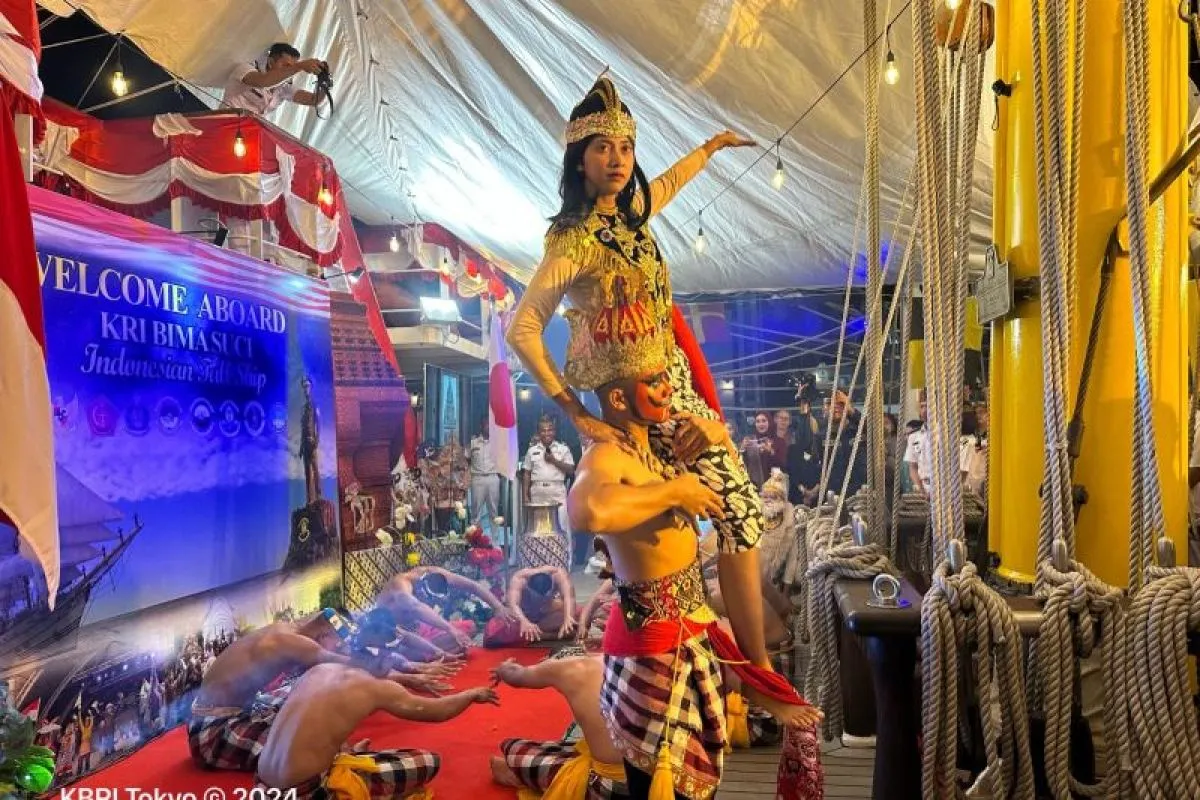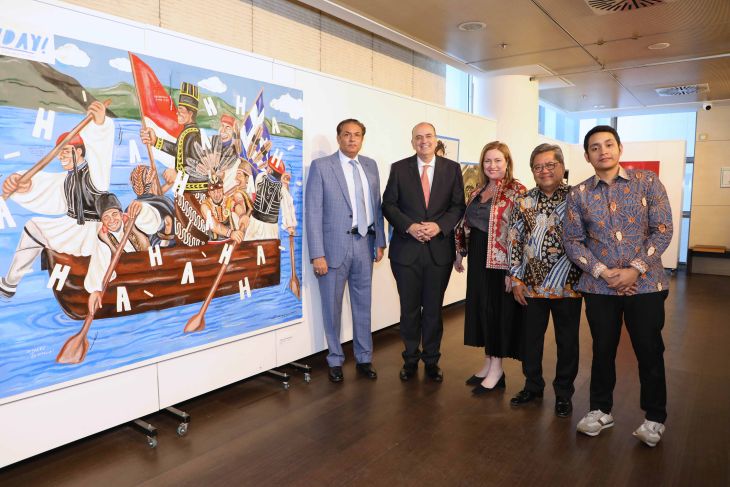Live Streaming
Program Highlight
Company Profile

International News (6887)
October
ASEAN, Japan and UNDP Announce Winners of ASEAN Blue Innovation Challenge
Written by nuke
List of the ASEAN, Japan and UNDP winners of the ASEAN Blue Innovation Challenge (ABIC), (Photo : UNDP) -
VOInews, Jakarta : ASEAN, Japan and UNDP officially announced the winners of the ASEAN Blue Innovation Challenge (ABIC), an initiative that aims to advance sustainable blue economy solutions in ten ASEAN countries and Timor-Leste. Launched in April 2024, ABIC is part of the ASEAN Blue Economy Innovation project supported by the ASEAN Coordinating Committee for Micro, Small and Medium Enterprises and implemented by UNDP, with funding support from the Government of Japan.
This initiative identifies and supports innovative solutions from ten ASEAN member countries and Timor-Leste that address pressing challenges in marine and freshwater ecosystems. The initiative received 1,341 proposals, of which 60 winners were selected by a Joint Selection Committee consisting of Satvinder Singh, ASEAN Deputy Secretary-General for the ASEAN Economic Community; Kiya Masahiko, Japanese Ambassador to ASEAN; and Norimasa Shimomura, Chief Representative of UNDP Indonesia.
These 60 winners represent a diverse range of innovators, and their solutions aim to improve sustainability in aquaculture, fisheries and tourism while addressing broader environmental challenges such as climate change, plastic waste and water resource management. Through technological innovation, community engagement and new financing models, this innovation project has the potential to generate positive environmental and social impacts across the region.
One other important piece of information is gender inclusion. Of the 60 winners, 27 of them (45%) were led by women, with a total of 125 female team members, exceeding the number of male members which amounted to 116 people.
Satvinder Singh, Deputy Secretary General of ASEAN said, “This project marks an important milestone in our journey towards sustainable blue economy development. By empowering local innovators and encouraging regional collaboration, we not only address pressing environmental challenges but also open new economic opportunities for ASEAN. I congratulate the 60 winners whose solutions have the potential to improve the future of our marine and freshwater ecosystems. I am confident that the partnerships formed through this initiative will drive long-term positive change across the region.”
According to a release received by Voice of Indonesia on Thursday October 10th 2024 in Jakarta, four focus areas covering sustainable fisheries, marine plastic pollution, sustainable tourism and climate issues, the winners emphasized the use of the latest technological advances in the blue sector to increase efficiency and environmentally friendly approaches.
In precision aquaculture, for example, award recipients from Brunei Darussalam, Malaysia, and the Lao People's Democratic Republic are using artificial intelligence (AI) and water filtration technology to optimize fish farming and increase local production. To demonstrate circularity in fisheries, award recipients from Cambodia, Indonesia and the Philippines transformed fish and shrimp waste and seaweed into valuable products such as fertilizer, microalgae and food supplements, promoting resource sustainability and community resilience. In biotechnology, solutions such as phage therapy (a medical treatment that uses viruses that infect and kill bacteria to treat bacterial infections) and the use of Bacillus probiotics to improve health or prevent disease in aquaculture ─ aim to improve fish health, while grass-based filters Oceans tackle microplastic pollution.
Award recipients from Myanmar, Singapore and Vietnam focus on plastic solutions, developing alternatives to agricultural waste, converting plastic waste into valuable products such as furniture and industrial materials, and facilitating the issuance of plastic credits in collaboration with local SMEs. In ecotourism, award recipients from Thailand and Timor-Leste are creating sustainable tourism models that involve local communities in conservation and waste management, driving environmental and social impacts.
This announcement also marks the start of a six-month incubation program for 60 winners. The program is designed to support the development of their proposed solutions at various stages of business implementation, from testing and proof of concept to scale-up and commercialization, equipping them with the tools to turn their ideas into impactful, scalable solutions. The winners are also entitled to funding of up to 40,000 US Dollars for 60 innovators//VOI
October
Indonesian Consulate General in Perth Promotes Indonesia Through Film Festival in Western Australia
Written by Daniel
October
Indonesian Ambassador Highlights Strong Diplomatic Ties During KRI Bima Suci’s Visit to Japan
Written by Ofra Regina Suharsil
Dance performance aboard the KRI Bima Suci at the Yokosuka Naval Base, Thursday (3/10) (Photo ny: ANTARA/Indonesian Embassy in Tokyo)
October
Celebrating 75 Years of Indonesia-Greece Cultural Ties: A Dynamic Artistic Collaboration
Written by Ofra Regina Suharsil
The exhibition features the olive wood sculptures 'RAMA SINTHA' by Balinese artists I Made Sumantra and I Made Suparta, the marble sculpture 'Antikythera Mechanism' by Greek artist George Kontonikolaou, and collaborative paintings by Indonesian artist Naufal Abshar and Greek artists Caroline de Souza and Pavlina Bechrakis. (ANTARA/HO/Pensosbud of the Embassy of Indonesia in Athens)
October
Minister of Tourism and Creative Economy Sandiaga Uno Promotes Batik at WCCE 2024
Written by Daniel
September
GlobE Network Pledges to Strengthen International Anti-Corruption Cooperation
Written by Ofra Regina Suharsil
Ilsutration of globe around the world (Photo by: pexels.com)
September

September
Scientists Track Plastic Waste in Pristine Canadian Marine Park
Written by Daniel
VOInews, Petit-Saguenay: Piles of old tires, discarded cups, and cigarette butts litter the stunning Saguenay Fjord, a marine conservation area in eastern Canada that attracts belugas and other whales seeking a respite. The fjord, flanked by glacier-carved cliffs, connects to the Saint Lawrence River and is far from any major city. This marine sanctuary has held protected status for 26 years.
"It's one thing to gain protected area status, but how do we maintain it?" asked Canadian biologist Anne-Marie Asselin before diving to search for trash. Along with her team from the Blue Organization, she navigates the brackish waters of the fjord to document pollution in the area.
Their objectives are twofold: to identify the most common types of waste to target plastics that should be banned from sale, and to predict which banks are most at risk of pollution, particularly based on currents, to better target cleanup campaigns.
Using paddleboards, walking, or freediving, Asselin and her team collect various types of waste in the bay of the village of Petit-Saguenay. Under the blazing sun, Laurence Martel from the group sorts the waste by over 100 criteria, including brand, to ultimately hold producers accountable for the entire lifecycle of their products.
"The most common find is the cigarette butt; it is omnipresent," Martel said. She noted that a single cigarette butt can contaminate up to 500 liters of water due to the thousands of chemical compounds it contains.
Over five years, the team's research has revealed a worrying trend: the concentration of plastic waste is significantly increasing closer to the Gulf of Saint Lawrence and the Atlantic, "suggesting a shift in waste from urban areas towards downstream parts of the river," she added. "Very often, the smallest plastics are the ones that pollute the most," Martel stated.
Waste breaks down into microplastics. These particles, often invisible to the naked eye, are made from polymers and other toxic compounds that vary from five millimeters to one thousandth of a millimeter. Microplastics are found throughout the marine food chain, particularly in invertebrates.
The Blue Organization captures and analyzes these "sentinel species," considered indicators of environmental health, during each cleanup operation. "If your mussels and your invertebrates are starting to suffer, that could be an indicator that the health of the ecosystem is also declining," said Miguel Felismino from McGill University in Montreal.
Seated on a catamaran, Felismino measured, photographed, and arranged mussel specimens, which he will also analyze in a laboratory to study the effects of microplastics. Using a homemade pump and a few pipes placed at the front of the boat, he also collected surface water and sediment from the seabed for his research.
The Blue Organization aims to produce a comprehensive picture of the plastic lifecycle in protected areas like the Saguenay-Saint Lawrence Marine Park. However, to protect these ecosystems, the solution is "also to trigger behavioral changes" in people, said biologist Asselin, who has called on artists to "raise awareness" about the situation.
This could involve creating music from natural sounds or producing a "literary translation" of scientific research, Asselin said. "With climate change, the soundscapes associated with certain territories are set to evolve," said one such artist, Emilie Danylewick, before plunging her hydrophone into the water to record the sounds. Danylewick added that her work is a "way to preserve the current soundscape memory of the territory."
Source: AFP
September
September
Britain is back and ‘open for business’, says trade policy minister on boosting economic ties
Written by nuke
British Prime Minister Keir Starmer leaves 10 Downing Street in London, Britain September 4, 2024. Britain, under his new Labour government, is pursuing new trade ties with the rest of the world. (REUTERS/Toby Melville/File Photo) -
VOInews, London : Southeast Asia is among the key engines of global growth in the years to come and poses “a huge commercial market”, said British Trade Policy Minister Douglas Alexander. The region has a population of about 680 million people and an estimated total gross domestic product amounting to approximately US$3.6 trillion.
“There are real opportunities, both for investments into the United Kingdom and exports from the UK to this global growth pool,” said Mr Alexander, who is currently in Laos to attend the Association of Southeast Asian Nations (ASEAN) Economic Ministers’ Meeting.
“We are here with a very straightforward and open message: Britain is back and we're open for business,” he told CNA on Wednesday (Sep 18).
Britain, under the new Labour government, is pursuing new trade ties with the rest of the world. British Prime Minister Keir Starmer has made economic growth the central mission of his administration, and sees giving businesses access to international markets as a key step. Mr Alexander said the UK is taking a “twin-track approach” to trade.
“We are seeking to reset and rebuild our trading relationships with our neighbours and partners in the European Union,” he added.
“At the same time, we're seeking to seize the opportunities of strengthening our trading relationships right around the world.”
The UK has been pursuing a range of free-trade deals since its departure from the EU.
“In every trade deal, there are complexities, there are challenges, there are negotiations that need to be resolved,” Mr Alexander noted.
“But I genuinely believe that liberalising trade and securing effective free trade agreements can be actual win-wins for both of the parties.”
By the end of this year, the UK will join the Comprehensive and Progressive Agreement for Trans-Pacific Partnership (CPTPP), an Asia-Pacific trade bloc.
“That's a market of about 600 million consumers. It includes some of the most dynamic growing economies anywhere on earth,” said Mr Alexander.
“So, that's a good example of the kind of modern trade deal that the UK is looking forward to striking now and in the years ahead.”
Several UK ministers are in the Indo-Pacific region this week for various talks, to show the Labour government’s new approach on the world stage.
“The Indo-Pacific is basically the fastest growing region in the world,” said British Minister for the Indo-Pacific Catherine West on the sidelines of the Milken Institute’s Asia Summit in Singapore.
While there are many opportunities available for its businesses, Britain also has “a lot to offer” the region, including areas such as education, climate change and culture, she told CNA on Wednesday.
“We're open for business,” she said, echoing Mr Alexander.
“We're going to have a sense of predictability, so that people are very clear that they can invest in the UK and we can have investments here in the Indo-Pacific. Together, we can have that prosperity that we all wish to see.”//CNA-VOI


